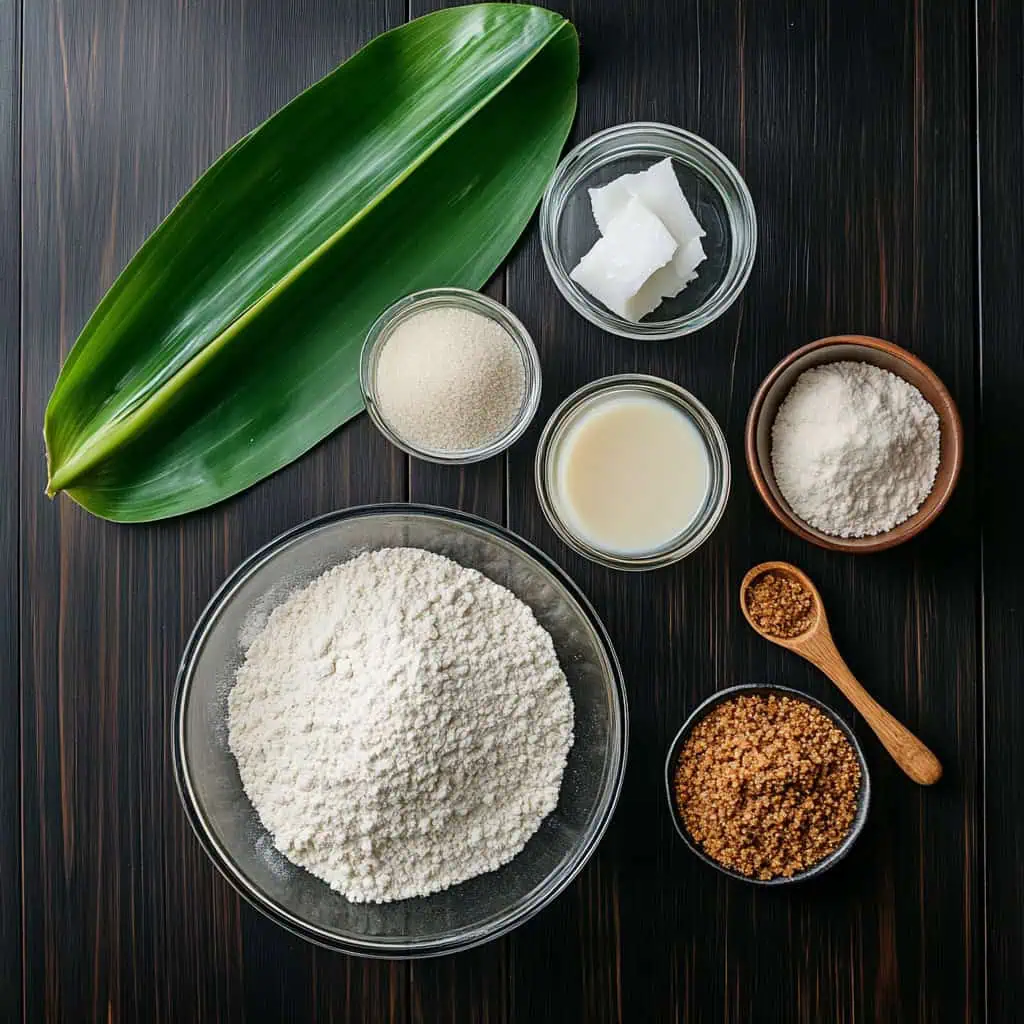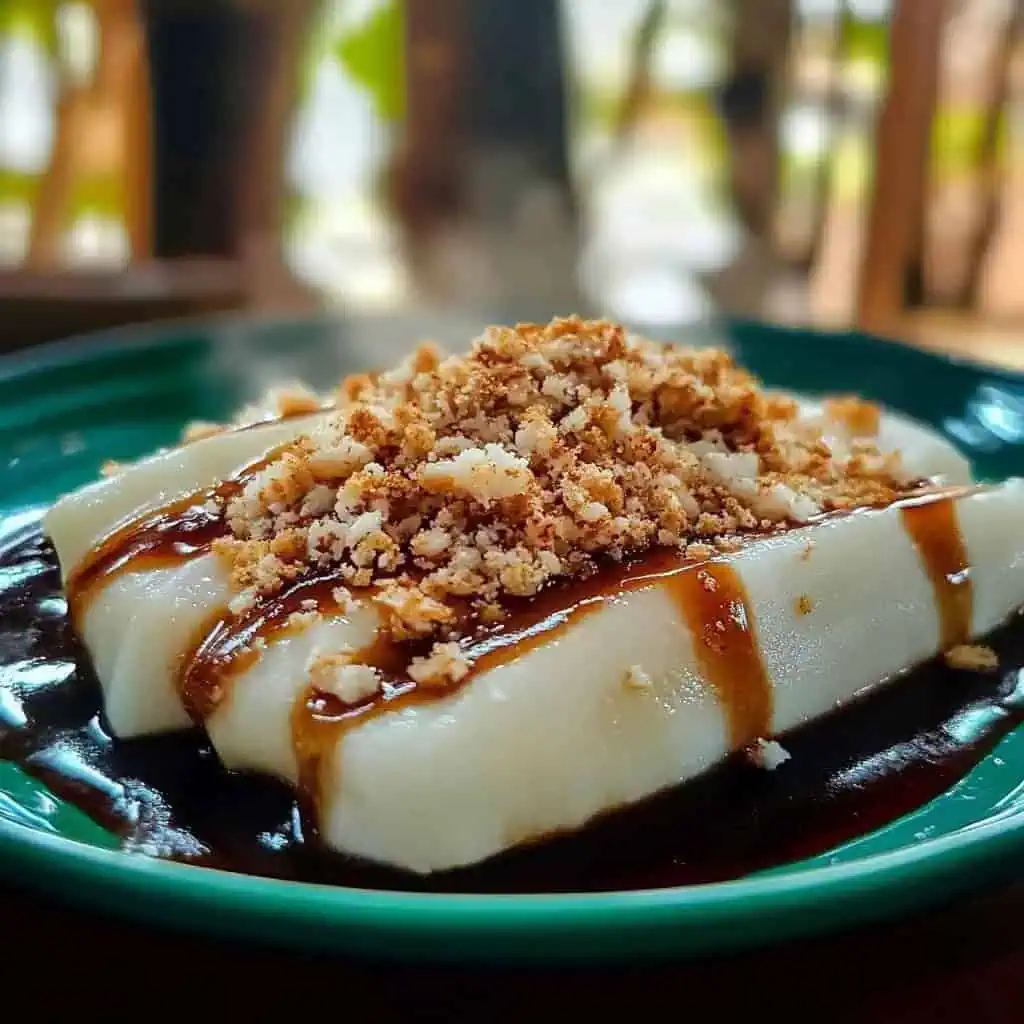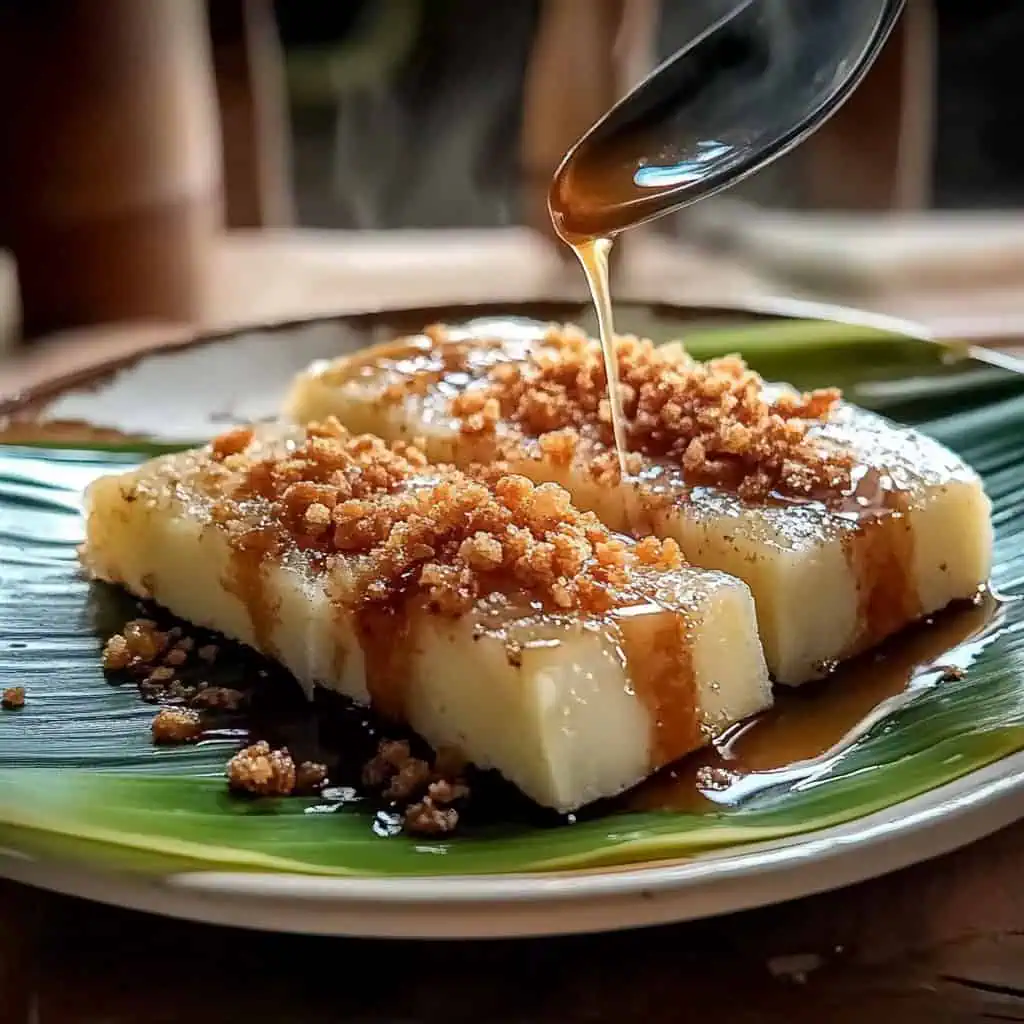I'll never forget the first time I tasted Binalay during a summer visit to my Tita Rose's house in Iligan, Isabela.
The sweet aroma of coconut milk reducing into latik filled her tiny kitchen as she taught me this treasured family recipe. As she unwrapped the banana leaf to reveal the perfectly steamed rice cake drowned in golden caramel latik sauce, I knew this wasn't just any ordinary kakanin.
My Tita Rose shared how this recipe has been passed down through generations, with each family adding their own special touch to the latik sauce - some making it more buttery, others more caramelized.
Now, whenever I make Binalay at home, the familiar scent of wilted banana leaves and coconut instantly transports me back to that small provincial kitchen.
This binalay recipe might seem intimidating at first, but trust me - if you've made puto or suman before, you can definitely master this Isabelino delicacy.
The key is patience while making the latik (which I'll guide you through step by step) and lots of love, just like how our lolos and lolas made it.
By the end, you'll have a treat that's perfect for merienda or any special gathering, guaranteed to make your whole family gather around the kitchen table asking for more.
Jump to:

Why You'll Love This Recipe
- Authentic Filipino dessert with the perfect balance of sweet and rich flavors
- Tender, chewy texture from glutinous rice
- Aromatic banana leaf wrapper adds a traditional touch
- Luxurious latik sauce that's worth making from scratch
- Perfect for merienda (afternoon snack) or special occasions
- Can be made ahead and reheated
Ingredients
Each ingredient in this recipe plays an essential role in creating authentic Binalay. The glutinous rice flour forms the chewy, sticky base that Filipinos love in kakanin. Banana leaves aren't just practical wrappers, they infuse the rice cakes with a distinctive aroma that's impossible to replicate.
The coconut milk transforms into two treasures: golden latik curds and fragrant oil. When combined with brown sugar, the latik creates a caramel sauce that's simultaneously rich, sweet, and complex.
These simple ingredients work together to create a dessert that showcases the ingenuity of Filipino cuisine, turning humble components into something truly special.

- 4 cups glutinous rice flour
- ½ cup water
- Banana leaves for wrapping, wilted
- Coconut oil for brushing
For the Latik Sauce:
- 4 cups coconut milk
- 1 cup water
- 1 ½ cups brown sugar
Equipment
- Steamer - Essential for cooking the wrapped rice cakes to the perfect consistency.
- Heavy-bottomed saucepan - Distributes heat evenly for making latik without burning.
- Wooden spoon - Perfect for stirring the latik continuously without scratching your pot.
- Strainer - To separate the latik solids from the coconut oil.
- Mixing bowls - For preparing the rice dough.
- Measuring cups and spoons - For accurate ingredient portions.
- Tongs - For safely handling hot banana leaves.

How To Make
- Prepare banana leaves: Clean banana leaves thoroughly and wipe them dry. Pass leaves over medium flame until they turn bright green and pliable. Cut into 8×8 inch squares. Brush with coconut oil from latik.
- Make latik sauce: Bring coconut milk to a boil over medium heat in a heavy-bottom saucepan. Reduce heat to low (around 160°F/71°C) and simmer, stirring constantly. Continue cooking until solids form and oil separates, about 15-20 minutes. Strain to separate latik (solids) from oil and set both aside.
- Prepare caramel: In a clean saucepan, combine water and brown sugar. Cook over medium heat until sugar dissolves and caramelizes, about 10 minutes. Add the strained latik to the caramel and mix well.
- Make rice cake dough: Combine glutinous rice flour and water in a large bowl. Knead until achieving a smooth, pliable dough. Divide dough into 10 equal portions and roll each portion into balls.
- Wrap rice cakes: Place one ball on a prepared banana leaf and flatten into a 3-inch diameter patty, about ½ inch thick. Wrap securely, folding sides to enclose. Place in steamer rack with seam side down.
- Steam: Steam over medium heat, maintaining water at a steady simmer (around 180°F/82°C) for 20 minutes. The rice cakes should be firm but springy to touch, and the banana leaf should have darkened slightly.
- Serve: Remove from steamer and let rest for 5 minutes before unwrapping. Serve warm, generously drizzled with the prepared latik sauce.

Tips from Lola's Kitchen
- Use fresh coconut milk for the best latik flavor - canned works but fresh gives a more authentic taste.
- When kneading the dough, aim for play-dough consistency - not too wet, not too dry. The dough should be pliable but not sticky on your hands.
- Don't skip wilting the banana leaves - passing them over flame not only prevents cracking but also releases aromatic oils that flavor the rice cake.
- Stir latik continuously to prevent burning and achieve an even golden-brown color. Never leave it unattended.
- Keep water at a steady simmer when steaming - too vigorous boiling makes tough cakes while too low heat leaves them undercooked.
- Let the Binalay rest for 5 minutes after steaming before unwrapping - this allows the rice cake to set properly.
- Temperature control is crucial for both latik-making and steaming. Use a kitchen thermometer if you're unsure.
Substitutions
- No banana leaves? While not traditional, you can use parchment paper or aluminum foil in a pinch, though you'll miss out on the unique aroma.
- Glutinous rice flour alternatives - If you can't find glutinous rice flour, you can use mochiko (Japanese sweet rice flour) as a 1:1 replacement.
- Fresh vs. canned coconut milk - Canned coconut milk works fine, but try to find ones without stabilizers for better latik formation. Look for brands with high fat content.
- Sugar options - Muscovado or palm sugar (panutsa) can replace brown sugar for an even more traditional flavor profile.
- Can't find brown sugar? You can substitute with white sugar mixed with a tablespoon of molasses, or use 100% white sugar, though the flavor will be less complex.
Troubleshooting
- Dough too dry? Add water in very small increments (1 teaspoon at a time) until you reach the desired consistency.
- Dough too wet? Add small amounts of additional glutinous rice flour until it reaches a pliable, non-sticky consistency.
- Latik not forming? Your coconut milk might not have enough fat content. Make sure you're using full-fat coconut milk, preferably without stabilizers.
- Burnt latik? If you've burnt it slightly, strain immediately. For a badly burnt batch, it's best to start over as the bitter taste will persist.
- Rice cakes still gummy after steaming? They likely need more time. Return to steamer for additional 5-minute increments until firm but springy to touch.
- Banana leaves breaking? You probably didn't wilt them enough. Make sure to pass them over flame until they become pliable and change to a brighter green.
Storage & Reheating
- Refrigeration - Wrapped rice cakes will keep in the refrigerator for up to 3 days in an airtight container. Store the latik sauce separately.
- Freezing - For longer storage, freeze the rice cakes (without sauce) for up to 1 month. Wrap individually in plastic wrap, then place in a freezer bag. The latik sauce can be frozen separately.
- Reheating rice cakes - Steam for 5-10 minutes until heated through, or microwave covered with a damp paper towel for 30-60 seconds.
- Reheating latik sauce - Warm gently in a small pot over low heat, adding a splash of coconut milk if needed to restore creaminess.
- Signs of spoilage - Discard if you notice any mold, sour smell, or unusual changes in texture. Properly stored latik sauce may solidify when cold but should melt when warmed.

FAQ
Can I make Binalay without a steamer?
Yes, you can create a makeshift steamer using a large pot with water and a heat-safe plate elevated on an inverted bowl. Cover the pot with a lid during steaming.
Why is my latik sauce grainy?
This usually happens if the sugar hasn't fully dissolved before caramelizing. Ensure the sugar completely dissolves in water before allowing it to caramelize.
How do I know when the rice cakes are fully cooked?
Properly cooked Binalay should feel firm but slightly springy when pressed gently. The banana leaf wrapper will also darken slightly.
Can I make the components ahead of time?
Yes, you can prepare the latik sauce up to 3 days ahead and stored in the refrigerator. The rice cakes are best made fresh, but can be made a day ahead and reheated.
Why did my banana leaf wrapping come undone during steaming?
You might not have secured the wrapping properly. Make sure to fold the sides tightly and place the seam-side down in the steamer to prevent it from opening.
Is Binalay gluten-free?
Yes, traditional Binalay is naturally gluten-free as glutinous rice flour doesn't contain gluten despite its name (it's called "glutinous" because of its sticky quality, not because it contains gluten).
Can I use this same latik sauce for other Filipino desserts?
Absolutely! This latik sauce works wonderfully with other kakanin like biko, suman, and sapin-sapin.
How do I make my Binalay extra special?
Some families add a small amount of butter to the latik sauce for extra richness, or sprinkle toasted sesame seeds between the layers of the rice cake for texture and flavor.
Related
Looking for other recipes like this? Try these:

Binalay ng Isabela (Sticky Rice Cake in Coconut Caramel Sauce)
Equipment
- Steamer (Pangkukus) for cooking the wrapped rice cakes
- Heavy-bottom saucepan (Kaserola) for making the latik
- Wooden Spoon (Sandok Kahoy) for stirring the latik continuously
- Strainer [Salaan] to separate latik from oil
- Mixing bowls (mangkok) for preparing the dough
- Measuring cups and spoons (Panukat) for accurate measurements
- Tongs [Sipit] for handling hot banana leaves
Ingredients
For the Rice Cake:
- 4 cups glutinous rice flour Galapong na malagkit
- ½ cup water Tubig
- Banana leaves for wrapping Dahon ng saging, wilted
- Coconut oil for brushing Mantika ng niyog
For the Latik Sauce:
- 4 cups coconut milk Gata ng niyog
- 1 cup water Tubig
- 1½ cups brown sugar Asukal na pula
Instructions
- Clean banana leaves thoroughly and wipe them dry. Pass leaves over medium flame until they turn bright green and pliable. Cut into 8×8 inch squares. Brush with coconut oil from latik.
- Begin making the latik sauce by bringing coconut milk (gata ng niyog) to a boil over medium heat in a heavy-bottom saucepan. Reduce heat to low around 160°F (71°C) and simmer, stirring constantly. Continue cooking until solids form and oil separates, about 15-20 minutes. Strain to separate latik (solids) from oil and set both aside.
- In a clean saucepan, combine water and brown sugar (asukal na pula). Cook over medium heat until sugar dissolves and caramelizes, about 10 minutes. Add the strained latik to the caramel and mix well.
- For the rice cake, combine glutinous rice flour and water in a large bowl. Knead (masahin) until achieving a smooth, pliable dough. Divide dough into 10 equal portions and roll each portion into balls.
- Place one ball on a prepared banana leaf and flatten into a 3-inch diameter patty, about ½ inch thick. Wrap securely, folding sides to enclose. Place in steamer rack with seam side down.
- Steam over medium heat, maintaining water at a steady simmer around 180°F (82°C) for 20 minutes. The rice cakes should be firm but springy to touch, and the banana leaf should have darkened slightly.
- Remove from steamer and serve warm, generously drizzled with the prepared latik sauce. For best results, let the binalay rest for 5 minutes before unwrapping.
Tips from Lola's Kitchen
- Use fresh coconut milk for the best latik flavor
- When kneading the dough, aim for play-dough consistency
- Don't skip wilting the banana leaves - it prevents cracking and adds aroma
- Stir latik continuously to prevent burning and achieve even color
- Keep water at a steady simmer when steaming - too vigorous boiling makes tough cakes
Nutrition
The Story Behind Binalay ng Isabela
In the heart of Cagayan Valley, nestled in the historic town of Iligan, Isabela, lies a cherished kakanin recipe that has been warming Filipino hearts for generations. Binalay, a beautifully crafted glutinous rice cake bathed in golden latik sauce, represents the ingenuity and resourcefulness of Isabelino home cooks who transformed simple ingredients into something extraordinary.
Like many beloved Filipino merienda treats, Binalay showcases the region's abundance of coconuts and rice - staple ingredients that form the foundation of Filipino cuisine. The technique of wrapping rice cakes in banana leaves, a method seen across Southeast Asia, takes on special significance in this recipe, where the leaves impart a subtle aroma that has become inseparable from the dish's identity.
What sets Binalay apart from other kakanin is its signature latik sauce. Unlike other rice cakes that might use latik purely as a topping, Binalay embraces it as a sauce, transforming the golden-brown coconut curds into a luscious caramel that enrobes each piece. This innovative approach to latik preparation has become a hallmark of Iligan's culinary heritage, making Binalay a must-try delicacy for anyone exploring the diverse world of Filipino desserts.
Today, this humble rice cake continues to be a source of pride for Isabela province, often featured in local festivities and family gatherings. While each family might have their own slight variations - some making the latik sauce more buttery, others more caramelized - the essence of Binalay remains unchanged: a testament to the enduring legacy of Filipino culinary traditions and the warm hospitality of the Isabelino people.
Have you tried other variations of this beloved rice cake from different parts of Isabela? Let me know your experience with this treasured delicacy in the comments below.










Comments
No Comments